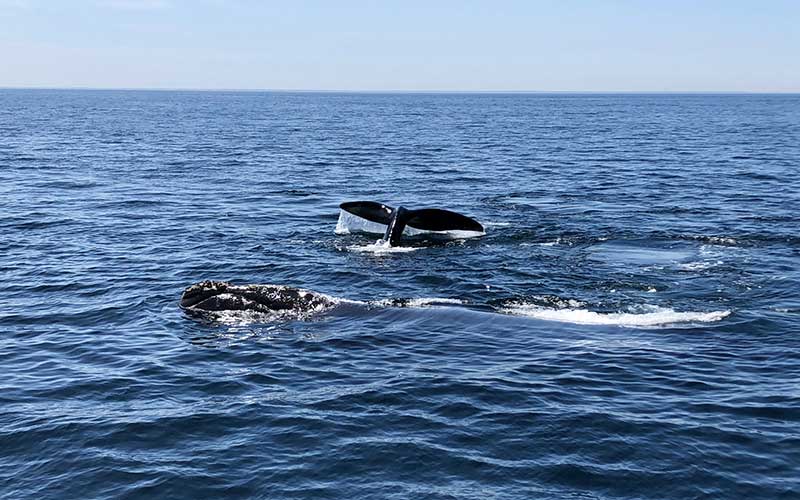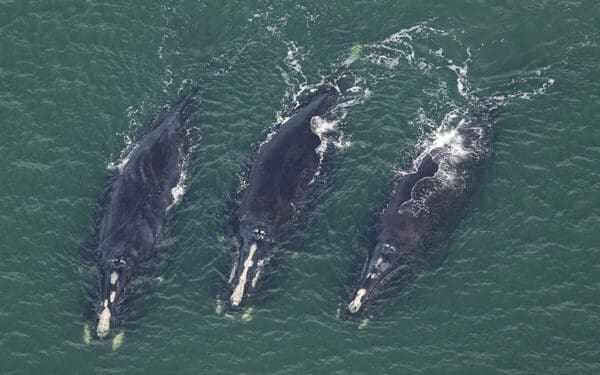
Because the North Atlantic right whale population is so small, spotting one in the wild is rare. But thanks to technology, you can learn about the whales' stories and where they are. Photo: Priscilla Brooks
North Atlantic right whales are on the brink of extinction. So few remain on the planet that your chances of spotting one of these unique creatures in the wild are sadly slim. But thanks to technology, you can spot New England’s native whales from your couch as they continue their migration north. While we’re all at home, it’s a great time to add whale watching to your quarantine activity list.
The Right Whale Population is Dangerously Small
The alarming status of the North Atlantic right whale has been in the news a lot lately. Since the summer of 2017, at least 30 whales have died – 10 died last year alone. There are barely 400 individual whales left on the planet.
North Atlantic right whales are expected to be “functionally extinct” – meaning the population has dropped so low that it can’t recover – within 25 years if we don’t act now.
Nearly all right whales die because of human activities: entanglement in fishing gear and ship strikes. This year, we celebrated when 10 calves were born – but even if that many were born every year, that’s not nearly enough to bring the population up to a healthy number.
We’re Not Giving Up on Right Whales
In the past year, CLF won two lawsuits demanding the federal government take immediate action to address the right whales’ plight. Last week, a federal judge ruled that federal fishery managers violated the Endangered Species Act when they authorized the lobster fishery. Our second lawsuit win came last year when the federal court ruled that opening waters south of Nantucket to gillnet fishing was illegal without appropriate analysis. These victories will help give right whales the protection they need from dangerous fishing gear.
CLF is also making sure that the public understands this critical issue by sharing the history of right whales, solutions to the current crisis, and, of course, updating you on tools you can use to track right whales yourself.
Find Out Where Right Whales Are Right Now
Ready to go whale watching from the comfort of your couch? Every spring, whales migrate up the busy eastern seaboard from Florida to Maine, then move on to Canada for much of the summer. To find out where whales have been spotted most recently, check out NOAA’s Interactive North Atlantic Right Whale Sightings Map.
Canada’s Department of Fisheries and Oceans also maintains an interactive map that’s updated every five minutes. It uses aerial, acoustic, and sighting data from multiple sources in Atlantic Canada. In the last two weeks, there have been several sightings in the Gulf of Maine and off the coast of Massachusetts.
Both of these resources also contain information about regulatory restrictions, like seasonal management areas, to help reduce ship strikes – the second leading cause of right whale deaths behind entanglements in fishing gear.
If you do leave your house and get out on the water, download the Whale Alert app so that you can easily report any sightings of your own. Just remember to stay 500 feet away from any whales you spot – and of course, comply with social distancing recommendations, too!
Every Right Whale has a Name and Unique Story
Scientists at the New England Aquarium keep track of every single North Atlantic right whale. This amazing compilation contains photographs of each whale, illustrations depicting identifying features, and whales’ birth years, as well as when and where each has been sighted. It is a fantastic resource, particularly if you’ve spotted a whale and want to try to identify it.
Take a moment to get to know just one of the hundreds of whales in the database: Clover, a female right whale born in 1986. She has had four calves and was last seen in 2018 on George’s Bank. You can see her records here, including some beautiful photos of her with her calves.
The sad reality is that because so few North Atlantic right whales remain, tracking them from home may be as close as most people will get. But getting to know these whales – their names and their stories, even through a tracking app and a web portal – is one critical way we can all ensure that these whales are not just a legend from New England’s past, but a visible and vibrant part of our present.
And, with swift action and additional protections, we can bring North Atlantic right whales back from the brink of extinction and give them a fighting chance for the future.



